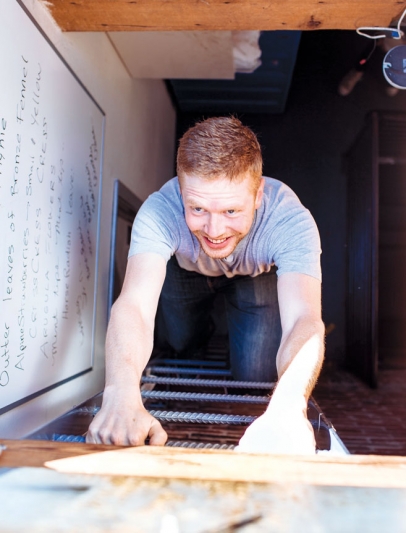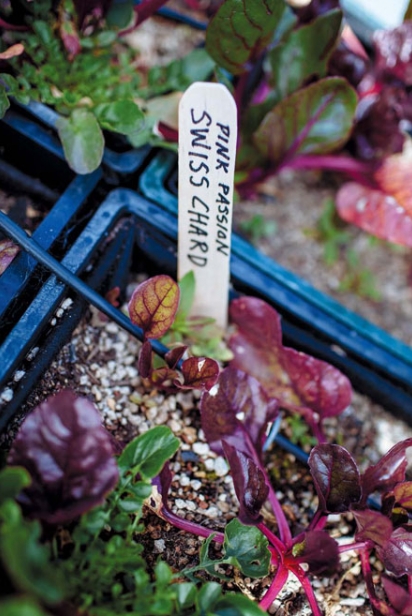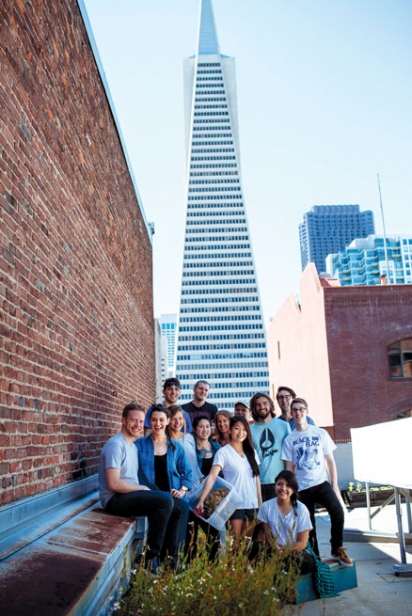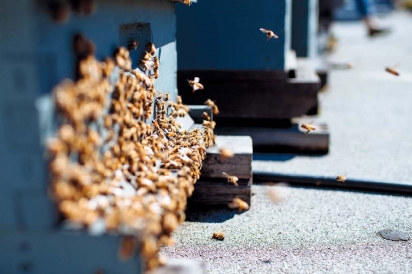Up on the Roof: Quince Restaurant
A Sanctuary Above the (Michelin) Stars
Right before service begins at Quince restaurant in San Francisco, Chef de Cuisine Jonathan Black keeps to a ritual that girds him for the intensity of a kitchen soon to serve 100-plus exceedingly expectant diners on this typical evening.
Carefully, one foot after the other, he pulls himself up a steep steel ladder that looks like it belongs more inside the bowels of a U-boat than a Michelin two-starred restaurant.
At the top, Black hoists himself through a crude opening in the ceiling that reveals the magnificent view of the late-afternoon sunlight on the nearby Transamerica Pyramid, the hum of buzzing bees, and the lovely scent of ginger mint, lemon verbena and tiny white Alpine strawberries that burst with intense rose-berry-pineapple flavor.
Black’s paradise is none other than Quince’s rooftop garden. In the Jackson Square neighborhood, where even parking is elusive, Quince’s owners Michael and Lindsay Tusk have managed to carve out space amid the industrial clutter of pipes and ductwork atop this landmark 1907 building to nurture provisions, creativity and peace of mind.
“You can usually find me up here at 5pm,” Black says. “I’ll pick the flowers or greens for use for the night. I can spend 10 minutes up here and calm down before service starts. When you can really get your hands on the plants and the soil, you get really inspired. And you can really taste the difference.”
Fashioned from nearly 200 repurposed milk crates that have been lined with fabric tarp to keep moisture and soil in, this unique garden along the perimeter of the top of the building allows Quince to go beyond farm to table—to roof-to-table cooking.
The specialty greens and herbs snipped just before service find their way into all manner of elegant dishes at Quince and in cocktails at its adjacent sister restaurant, Cotogna. Having a garden conveniently upstairs from the kitchen affords the chefs the ultimate in freshness, as well as the flexibility of using every part of the plants, from root to shoot, from flower to seed.
The garden—which is organic, though not certified as such—may not necessarily save the restaurant anything in food costs, but it pays off in other ways.
“Anytime you go up there, it’s an added bonus for the day,” Chef-Owner Michael Tusk says. “You’re not waiting to sign an invoice for something at the back door. I’ll see Jonathan coming down with nasturtiums or a young cook getting something for his station. It’s been a resounding success, and can only get better the more we learn about San Francisco weather and what you can do on the roof.”
It took a couple fits and starts to get it to that point, though. It all began with the bees. Or, rather, beekeeper Terry Oxford’s gumption and her admiration of Tusk’s cuisine, having had what she calls “one of the best meals of my life” at Quince’s previous location on Octavia Street.
Oxford, an urban beekeeper who is the founder of UrbanBeeSF, happened to be strolling past Quince’s current building one evening five years ago when she tapped on the street-front window that looks into the kitchen. A bewildered Tusk went outside to see what was up.
“Funny enough, he said he’d been thinking about bees on the roof just the week before,”“ she says. “I intuitively knew he would honor bees in the same way I do because he honors good food the way he does.”
A month later, Oxford had her bees installed on Quince’s roof. Not long after that, the garden started taking shape to supply not only the kitchen with edibles, but the bees as well.
An eager restaurant employee took charge of the project, but with a lack of real horticultural know-how, the garden eventually fell into disrepair. Even though it languished for months, Tusk never considered abandoning it.
“That didn’t cross my mind,” says Tusk, who has longed for a rooftop garden since visiting the successful one at Chef Sean Brock’s celebrated restaurant, McCrady’s, in Charleston, S.C. “It was just frustration. I’d look at the roof and think, ‘We’ve got to get it looking nicer.’ It was always in the back of my mind to continue it, but redefine it.”
All it took was a fortuitous visit by Xander Wessells last winter to do so. Wessells and her husband, Kevin Sadlier, a former chef in Florida, own the organic nursery Green Jeans Garden Supply in Mill Valley. Wessells’ family is also neighbors with Lindsay Tusk’s family in Maine. And Sadlier has supplied foraged mushrooms to Quince for about 15 years.
Last winter, Wessells was delivering plants that had been purchased to adorn the front of the restaurant when Michael Tusk invited her to take a look at the rooftop garden.
“He was so depressed,” Wessells recalls. “Everything was dead. We had to start from scratch. We cleaned up what wasn’t successful. We are bringing it back to life.”
Now, Wessells visits the roof once a week to tend to the garden and to confer with Black, who was anointed the point person to help choose what is planted there.
“I don’t know if I necessarily have a green thumb,” Black says with a laugh. “I graduated culinary school at 21 and went to work on a farm in Ohio. Then I worked at a few restaurants with farms. So, ever since then, it’s been a big thing for me.”
It’s so important to him that he’s one of a half dozen chefs, servers, sommeliers and bartenders who volunteer the first Sunday of every month to work on the garden bright and early, often less than sevenStaff members from Quince and Cotogna and farmer Xander Wessells hours after the end of their shift. Armed with sunscreen and boxes of pastries to start the day, the Quince crew pulls up weeds, sifts soil to reuse and tags along behind Wessells as she explains how to care for each type of plant. They’ve become so adept that they can take over the garden in Wessells’ stead when she’s on vacation.
“A lot of chefs show up for the work days. I don’t even know how they have the energy,” Wessells says admiringly. “They’re perkier than I am on those mornings.”
The garden was designed to be a closed system. Each milk crate, which can be easily moved to a sunnier or shadier side of the roof if need be, is hooked up to drip irrigation. The run-off goes to the five bee hives, which need water to survive. The bees snack on the plants, helping to pollinate them. Weeds and kitchen scraps are composted in four worm bins, producing castings rich in nutrients that are used to fertilize the plants.
Sometimes unintended consequences prove fruitful, too, such as when watercress planted in one crate started propagating in others, its seeds having been carried by the wind.
“The other night, we didn’t have enough watercress, so a cook asked me if I wanted to axe that dish that night,” Black says. “I told him to just go weed the planters, as the watercress we planted was popping up unexpectedly in other parts of the garden because it is a weed.”
The garden’s bounty, which is intended to supplement, not replace, all of the produce needed at Quince, gets used in different ways. The honey and honeycomb do star turns on cheese plates. Lemon thyme leaves get mixed into dough for savory tarts. Lemon verbena infuses oil that dresses an upscale Greek salad of tomatoes, cucumbers and frozen feta pearls. Pansies, Bachelor Buttons and radish flowers garnish a dazzling dish of caviar with creme fraiche and brioche.
“We try to choose things to grow that are appropriate,” Wessells says. “We can’t do actual vegetables because it’s such a small space. So we won’t grow pumpkins or peppers or even tomatoes, which they can just get a huge bushel of at the farmers’ market. We are limited in what we can grow enough in quantities of for a restaurant like this.”
Instead, heeding the chefs’ preferences, Wessells grows more unconventional items such as peppercress, sorrel, bronze fennel, stinging nettles, horseradish, an assortment of mints for the bartenders to use in craft cocktails, and Red Orach, with its striking scarlet leaves that can be eaten raw or cooked.
Her goal is to get the garden into a rhythm. When one item is ready to be picked, other seeds will be started, so that there always will be something to harvest, year-round.
This is the only restaurant garden that she oversees. It is not without its challenges. After all, everything needed must be hauled up that notorious ladder—always an adventure in and of itself.
But it is not without its perks, too. One afternoon just before taking a break, Wessells and her assistant ordered a pizza from Cotogna below. Minutes later, a chef handed the wood-oven blistered pie to them on the rooftop—the ultimate in delivery service.
Just how many gardens can boast that?










